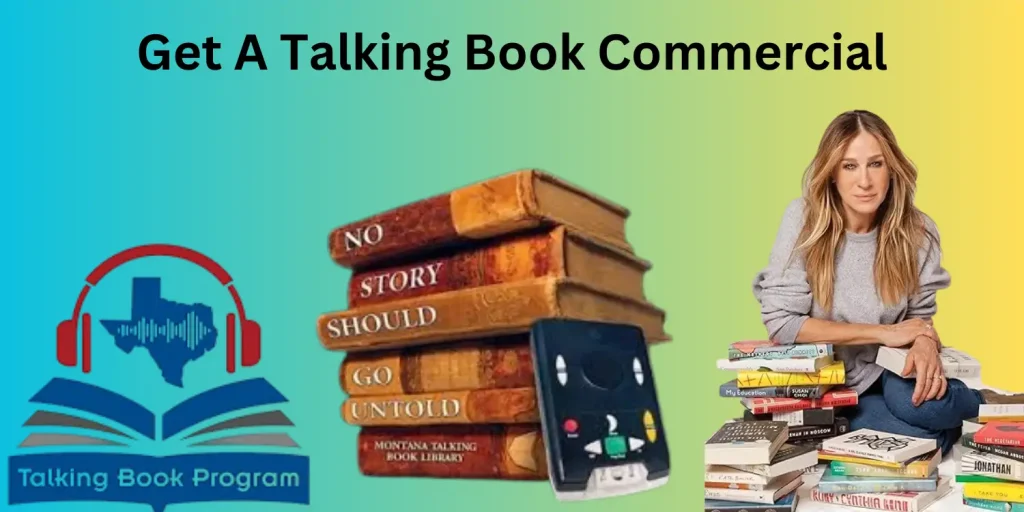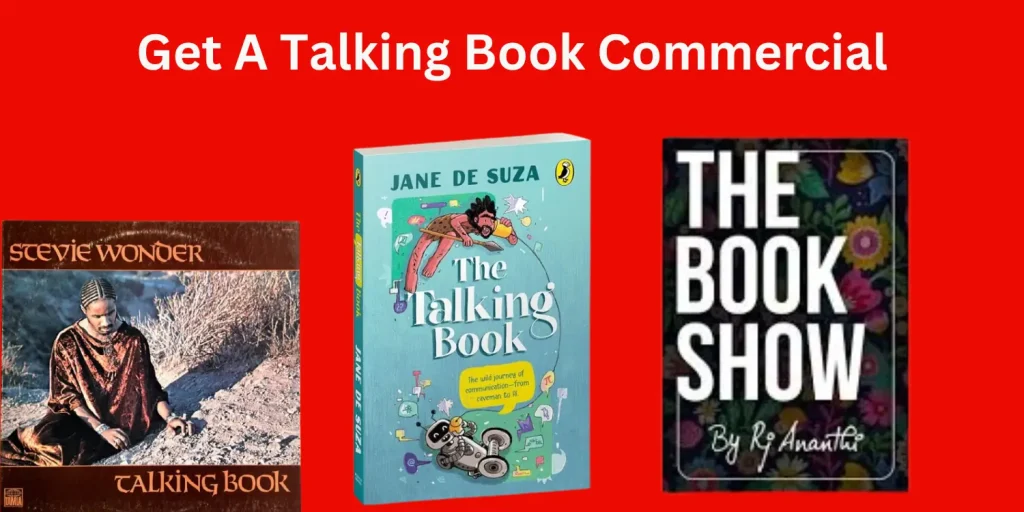introduction about talking book commercial?
Talking Book-Creative engaging promotion of audiobooks exists through talking book advertisements. These audio-based advertisements reveal story elements such as plot structure and setting and characters so readers can experience a promotional listening journey before purchase. Different from traditional book promotions the talking book ad offers a dynamic marketing experience that uses voices together with special sound effects and musical components to make written content more immersive.
Attracting audience involvement stands as the core goal of talking book advertisements. These promotions present selected script sections drawn from audiobook recordings with expert reader voices which successfully capture the narrative essence. Through sound effects and background music parsing the content becomes both stronger and more dynamic for better retention in the audience memory space.

Users who enjoy audio formats including radio dramas and spoken word performances will discover this method particularly suitable. Platforms that serve digital and audio delivery focus best on promotional communications for listening book solutions. These ads target radio listeners and social media audiences while also reaching streaming platforms alongside other audio-oriented digital platforms that attract content-oriented audiences.
Audible and Spotify users can learn how to purchase audiobooks through action-oriented messages located within these commercial advertisements. This marketing approach mirrors audiobooks’ growing market demand because of our modern world’s emphasis on convenience and task-switching-based consumer habits. These audio promotions teach people about audio storytelling while providing brief glimpses into audiobooks as they familiarize viewers with the listening experience.
This innovative advertising method unifies audio entertainment and literature approaches to reach more book consumers who use modern technology.
What is the talking book used for?
A talking book exists as a device which enables people with reading difficulties to listen to textual information easily. The device enables access to reading content for individuals with dyslexia and those who are blind or visually handicapped along with individuals whose physical disabilities make it impossible to hold conventional documents.
The talking book enables inclusive document interaction thus establishing itself as an essential tool for educational progress and enjoyment. Users access talking books through three main channels which include digital audio files together with audiobooks on CDs along with dedicated player cartridges that support special formats. These devices and files enable users to play different forms of media such as newspapers and periodicals as well as textbooks and novels.

Modern talking books enable users to move between chapters and sections and pages through flexible navigation controls. Programs set up for disabled people with certification receive equal access to education and entertainment resources as part of their mission. Through accessible format talking books readers can perform multiple tasks since they enable simultaneous listening and alternate activities.
Listening users and work commuters appreciate this audio service along with those who seek relaxation or increased productivity. The talking book technology provides printed information access for all readers regardless of their ability to handle traditional printed materials. Through their mission to promote independence and improve lives and foster reading and learning passion they empower people.
When was the talking book invented?
Audiobooks and talking books exist today because of their origin during the early part of the 1900s. People began to favor the spoken word audio recording concept for accessibility purposes to books during the 1930s for those who had visual disabilities. The Library of Congress launched their Talking Book Program in 1932 yet the American Foundation for the Blind (AFB) partnered with them to establish this concept.
The initiative aimed to make literature available for people with both blindness and visual handicaps. People used phonograph records as devices to record and reproduce sound for the production of the first talking books. Records from that period were limited to a short amount of audio time which resulted in brief recordings.
Although imperfect the talking book served as a groundbreaking advancement which expanded literature accessibility across broader reading communities while ranking Shakespeare’s dramas The Bible and The Declaration of Independence among its first published selections. The technology developments in the 1940s allowed producers to extend recording time while expanding their selection of content.
During the 1960s and 1970s cassette tape technology advancements allowed major improvements to the portable and easy-to-use characteristics of the talking book format. Digital audio formats together with CD distributions made audiobooks better accessible and higher quality as the technology progressed during the late twentieth and early twenty-first centuries.
Digital streaming services together with smartphones have increased the audience for talking books so that people from all walks of life now enjoy these recordings. Technological advancements including voice synthesis and artificial intelligence have boosted both accessibility and appeal of talking books. The technology introduced new pathways to shared enjoyment through a reading experience which transformed the traditional approach people conducted reading.
What is the purpose of speak book?
The speakbook also known by its other name audiobook aims to deliver flexible listening access to reading materials. With speaker books consumers can play stories and lessons and receive information through audio while normal books demand active page-by-page attention. This popular format has gained favor due mainly to its numerous attractive features. Enhanced accessibility stands as a fundamental purpose of today’s talk books.
People with learning disabilities including dyslexia and visual impairments together with other reading obstacles can easily access literature and informational content through this format. By integrating narrators alongside music and sound effects audiobooks offer immersive listening experiences and they also adapt to different lifestyles.
Americans who listen to audiobooks have the flexibility to use this content during workouts and their commutes as well as their household duties. Restored reading accessibility enables people to integrate reading activities seamlessly into their daily lives without creating dedicated reading hours. People using Speak Books get to choose from an array of learning methods.

The auditory experience of hearing knowledge allows certain individuals to better hold onto information in their memory. The acoustic experience enhances understanding of complex themes coupled with tone perception and emotional listener engagement throughout fiction and personal narratives. Through speak books users develop their ability to learn languages as they experience various cultures while reading.
qualified readers and fluent speakers who narrate books provide listeners the ability to enhance their pronunciation abilities together with fluency and intonation skills. A speak book aims to create more accessible delivery of storytelling content while making these stories adaptable for all users and enhancing the enjoyment of text content exchange. Through this innovative approach literature and knowledge remain accessible to a diverse audience because it eliminates the separation between conventional reading methods and modern daily routines.
What are the benefits of book talks?
The advantages of book talks
Book talks are lively conversations that introduce books to a group of people, encouraging a love of reading and enhancing literacy. These are the main advantages:
1. Promoting a Passion for Reading
Book talks pique interest by showcasing literature in an engaging manner. They encourage readers to read the book by highlighting intriguing characters, stories, or themes without giving away any spoilers. This method makes reading fun and engaging, especially for those who are reluctant to read.
2. Enhancing Communication Capabilities
Participants and speakers both improve their communication skills. While listeners engage in active listening and pose meaningful questions, presenters develop their ability to express themselves succinctly and convincingly. This conversation improves confidence and critical thinking.
3. Establishing a Community of Readers
Book discussions foster connections between people via shared interests and provide a forum for literary encounters. By exchanging ideas, suggesting related books, and having deep discussions, participants can improve their social ties and create a feeling of community.
4. Encouraging Diverse Viewpoints
Book lectures allow attendees to examine ideas and experiences outside their own by introducing them to a diverse range of genres, authors, and cultures. This exposure increases empathy, variety appreciation, and understanding.
5. Encouraging Cognitive and Academic Growth
By provoking conversations about themes, characters, and writing styles, book talks promote critical thinking. Participants gain abilities that are critical for academic achievement, such as text interpretation, literary device recognition, and the development of well-reasoned arguments.
6. Promoting Lifelong Education
Book presentations highlight how learning may be continuous and pleasurable. They encourage curiosity and a lifetime love of reading by motivating participants to investigate novel subjects, genres, or writers.
In conclusion, book discussions are an effective way to encourage reading, critical thinking, and social interaction that benefits both people and communities.
How do you use a talking book?
Talking book refers to audio recordings that provide a standardized means of accessible reading materials to users ranging from those who experience reading difficulty to blind individuals to auditory learners. The steps involved in using a talking book are simple and include the following:1. Your talking book needs a proper device which can be a standard PC or smartphone and tablet system alongside specialized DAISY devices and everyday MP3 music players.
Keep searching because libraries along with download platforms give out multiple apps which include Libby and OverDrive and Audible to access these books. 2. Choose Your Book Among all available titles on your device choose the one you want. Subscription platforms like Audible provide purchase and rental content while libraries remain free to readers when they offer talking books.
Choose the book you want after downloading it onto your device or get access by plugging in physical discs like CDs or USBs. 3. Select playback parameters through preferences adjustment according to your needs. Users can upgrade volume levels and adjust both pitch settings and playback speed for numerous audio books. Every section within DAISY books is available for easy exploration.
4. Press the play button when you want to hear the audio narration. You can navigate your way through the book by using the options to skip forward or rewind or place a temporary pause. Bookmark capabilities are available across numerous platforms allowing readers to start precisely where they exited previously.
5. If you need accessibility features your reading experience can improve through using screen readers and text-to-speech capabilities which modern devices provide. Listening to digital books creates flexible reading experiences and social inclusion and provides users with enjoyable listening access to information and reading materials.
Conclusion talking book commercial?
A talking book commercial’s conclusion:
You can access entertainment combined with education and motivational storytelling through talking books when speed becomes a major factor. The platform enables users to make the ordinary exercises of fitness routines or cooking or travel into engaging pursuits. Clicking on “Play” begins an extraordinary audio experience that transports listeners through lively narrations which guide you into captivating fantasy realms and intricate criminal investigations and heartwarming stories.
Stories represent only one aspect of the experience. Through its delivery of expert guidance and inspirational teachings and practical skills at your convenience talking books transform into tools for personal development. Our expansive library contains material for all interests that spans classic literature alongside educational content and easygoing entertainment pieces.
Consider the options. Your free hands combined with an active mind can study and laugh or weep and become better at any activity while under this system. Talking books succeed with all audiences because they adapt seamlessly to dreamers and learners who read extensively along with busy individuals who juggle multiple tasks at once.
Our platform now provides the simplest possible way for you to begin benefiting from our services. Our accessible platform enables users to read their favorite books whenever and from wherever they want. You can start the play function to enjoy the magic while leaving page-turning and quiet locations behind.
Why wait, then? Your access to coveted stories and essential lessons begins when you click the screen. Get ready to let storytelling make your life completely exceptional by becoming one of the numerous people who now savor audiobooks.
The journey starts at [yourcompanyname.com] to sign up right now. Our talking books serve readers both experienced and beginning their storytelling journey to elevate their overall life experiences through enjoyment and transformation.
Table of Contents